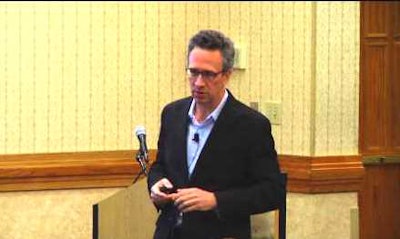 Dr. Davis Jenkins is a senior research associate at the Community College Research Center and co-author of the report.
Dr. Davis Jenkins is a senior research associate at the Community College Research Center and co-author of the report.Only 14 percent of students who transfer from community college to a four-year school graduate with a bachelor’s degree within six years, according to a joint study from the Community College Research Center (CCRC), Aspen Institute College Excellence Program and National Student Clearinghouse (NSC) Research Center.
Unpacking that number a bit, it should be remembered that not all students choose to transfer to a four-year college from a community college. Nor is it a perfect snapshot of community college transfer student success overall. Case in point, a recent NSC study found that, on average, community college transfer students attain their bachelor’s degree within three years after earning their associates.
Dr. Davis Jenkins, a senior research associate at CCRC and co-author of the report, said that the purpose of the study was to look at measures and characteristics that help two- and four-year colleges succeed in terms of their transfer student graduation rates. Moreover, “momentum matters,” he said, with regards to completion rates.
“It’s true that if we tracked all the states and institutions over a longer period, we would see higher rates, but research we’ve done suggest that institutions that do better in the short term, also do better in the longer term,” he said. Over the years, students lose access to certain resources, such as the Pell Grant program, which has a six-year eligibility limit.
Overall, Jenkins said, “There’s a surprising amount of variation in outcomes at both two- and four-year colleges.” Certain characteristics, such as a rural location or low-income student population, he added, which might be expected to be an indicator of lower outcomes, turn out not to be. There is also a great deal of variability among states, and within states, variation among institutional states.
On average, certain four-year institutions do a better job at helping community college transfer students graduate. Public four-year colleges tend to do better than private four-year colleges, while for-profits have very limited success. The report found that less than 10 percent of community college transfer students graduate with a bachelor’s degree in six years from for-profit colleges.
“All of this is promising to us because it suggests that the type of students that colleges serve and the type of institution they are doesn’t necessarily determine outcomes, but this suggests that what colleges do makes a difference,” Jenkins said.
As for why some institutions and states have better success with their transfer student population, Jenkins said, “My strong hypothesis would be that in general the transfer process is extremely difficult to navigate.”
The report found that students from lower socioeconomic backgrounds transferred to four-year institutions at a lower rate than those from higher socioeconomic backgrounds. The breakdown was a 28 percent to 36 percent split, respectively. Jenkins attributed this disparity to the difficulty of the transfer process and the cost of college overall: not all states or institutions have finely tuned course articulation agreements, meaning that students may take classes that do not count toward their chosen major or program, depending on to which institution they would like to transfer the credit.
“Research suggests that, in general, wealthier people make mistakes just like people who don’t have as much money, but there’s much less margin for error when you’re poor,” Jenkins said. “When you take courses that don’t count as credits toward a major and you’re wealthier, you can absorb it, but the same situation can be really devastating when you don’t have a lot of resources or time.”
Staff writer Catherine Morris can be reached at [email protected].















